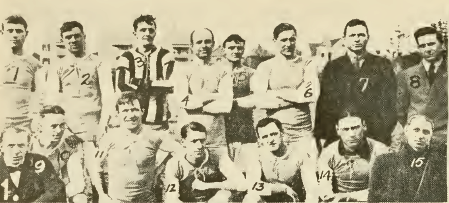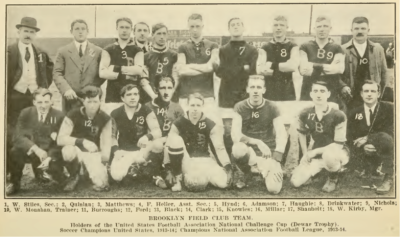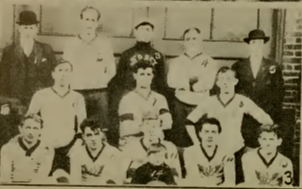Photo: West Philadelphia FC, 1913-14
Our series looking at Philadelphia soccer happenings one hundred years ago continues.
Philadelphia’s winter weather often disrupted the soccer schedule, as was the case throughout the various centers of the game along the northeast coast of the US. On Jan. 24, 1914, the conditions were so bad that not a single scheduled game was played in Philadelphia. Among them was the scheduled National Challenge Cup match between Peabody FC and the St. George team of New York. The Inquirer described on Jan. 25, “The game has been played on many worse days, but the frost, combined with the rain, converted the various grounds into a sea of mud.”
Only one game involving a Philadelphia team was played on that Saturday match day when, some 250 miles to the north, West Philadelphia faced New Bedford in the United States of America Football Association-backed National Challenge Cup. On Sunday, Jan. 25, Bethlehem would be on the road to face Brooklyn FC in National Challenge Cup play while Victor would try one more time to top Jersey AC in the third round of the American Football Association-backed American Cup tournament.
West Philadelphia knocked out of first National Challenge Cup
West Philadelphia had advanced to the third round of the inaugural National Challenge Cup, known today as the US Open Cup, with a 4-1 win on Dec. 5, 1913 over Kensington FC after enjoying a first round bye. And while the West Phillies may have avoided the seas of mud that were Philadelphia’s soccer fields that weekend, conditions at New Bedford’s Atlantic Field were little better.
Still, some 2,000 spectators were on hand as the visitors started brightly. The Philadelphia Inquirer described on Jan. 25, “Despite sodden rains which made the football field resemble a swamp, the Philadelphians played rings around their opponents in the first half.” According to the Inquirer match report, it was only the “brilliant goal tending” of New Bedford’s goalkeeper, “who saved miraculously on several occasions,” that kept West Philadelphia from tallying.
Scoreless after the first half, the Inquirer reported, “The second half saw the Philadelphians repeat their successful tactics,” but still they could not find the back of the net. This despite West Philadelphia forward line having “penned the Whalers in on their goal line.”
With second half time running out, a breakthrough would come, but West Philadelphia would be the victim when New Bedford inside right Klemm scored on a breakaway. Soon after, New Bedford inside left Chadwick made it 2-0 and West Philadelphia’s cup run was over. According to the Inquirer match report, the result was “the irony of fate” with West Philadelphia “monopolizing two-thirds of the play,” only for New Bedford to “score a couple of cheap goals in the last eight minutes of play, and waltz off to an unearned victory.”
Bethlehem knocked out of the National Challenge Cup
Bethlehem had advanced to the third round of the first National Challenge Cup after crushing Disston AA 7-0 on the first round on Nov. 1, 1913 before traveling to Pittsburgh to defeat Braddock 3-2 in extra time on Dec. 6 in the second round.
On Sunday, Jan. 25, Bethlehem traveled to the Marquette Oval to face Brooklyn FC, who had been knocked out of the American Cup the previous weekend in Philadelphia by Tacony. Field conditions were poor for Bethlehem’s first-ever trip to New York City, the Inquirer reporting on Jan. 26, “The heavy going materially affected the playing of the Allied Leaguers, which just suited the weighty players of the locals, who appeared to revel in the mud.”
After a scoreless first half, the decisive moment came some 25 minutes into the second period when Bethlehem inside right Edgar Lewis was called for a handball inside his team’s 18-yard box. Brooklyn’s Bob Millar’s penalty kick was initially saved by Bethlehem goalkeeper Robert Scaife but he couldn’t hold on to the ball and Brooklyn right fullback Hynd pounced to score the only goal of the game.
The Inquirer reported, “It was tough luck on the Bethlehemites in being eliminated by that dreaded penalty, and even the home players did not relish beating their opponents by so scant a margin, as they had fully expected to have won more easily before the game.” For Bethlehem, it was their first loss in all competitions of the 1913-14 season. They would not lose another game for nearly 14 months.
When the National Challenge Cup tournament had kicked off in November of 1913, eight area teams were in the competition. With the elimination of West Philadelphia and Bethlehem, now only one local team, Peabody FC, remained.
Victor knocked out of American Cup tournament
By the time Victor of Philadelphia’s professional Pennsylvania League met Jersey AC in the third replay of their third round game of the American Cup tournament on Jan. 25, 1914, Hibernian and Tacony had advanced to the semifinals — Hibernian with a 3-1 win over reigning champions the Paterson True Blues on Jan. 10, Tacony with a 2-1 win over Brooklyn FC on Jan. 17. Bethlehem was still waiting to meet the West Hudsons in their fourth replay of their third round cup tie. After the first game had ended with a 1-1 scoreline, poor weather saw the second replay abandoned late in the second half with the score tied at 1-1. The third replay had finished with the same scoreline.
The first third round game between Victor and Jersey AC had taken place on Dec. 27, 1913 at Front and Erie and ended in a 1-1 draw. Playing away Jan. 11, 1914 at Jersey City, the two teams had battled through 90 minutes of regulation and 30 minutes of extra time to a 0-0 draw. Playing again on the road at the West Hudson Oval in Newark on Jan.25, the contest was for Victor another otherwise rare opportunity to play a Sunday game, something that was prohibited back home in Philadelphia by Pennsylvania’s Blue Laws.
The Inquirer acknowledged that Victor were the underdogs, writing on Jan. 25, “the Pennsylvania Leaguers will have a hard task to accomplish in eliminating the Jerseymen from the competition.” The key would be speed “to beat their more heavier opponents, who will be right at home should their grounds be on the soft side.”
Victor made a terrific start, led by John Cooper, the Inquirer match report of Jan. 26 declaring the center halfback had “played one of the greatest games seen on the West Hudson Oval in some time.” Cooper would tally two first half goals “on pretty drives almost forty yards from the goal posts.” Victor outside left Bingham also scored and the Philadelphia side was leading 3-0 at the half. As the Inquirer reported, “it appeared as if the Philadelphia team would win easily.”
And then things fell apart.
With two minutes left in the game and the score now tied at 3-3, Jersey AC left fullback Charles Fisher would, “amid the greatest excitement,” score the game-winner for the home team and so end Victor’s American Cup tournament run.
Both Victor and Bethlehem would file protests after their losses. Victor argued that Jersey AC had taken more than the allotted time at the half and so were late to take the field for the start of the second half. Bethlehem argued that Brooklyn was 30 minutes late for the start of their National Challenge Cup game and also questioned the eligibility of several players.





Ed, great article about a great period in US soccer history.
The Jersey AC goal scorer, Charlie Fisher, was actually a forward and scored three of the goals that day. The referee was quoted as saying that game was one of the most exciting he had ever seen.
Charlie Fisher played for the Clark AA, Paterson Wilberforce, Paterson True Blues, Harrison Alley Boys and Paterson Rangers in addition to the Jersey AC.
Fisher was also signed by the Philadelphia Hibernians in 1910 to strengthen their club for a trip west to St. Louis. He was suspended by the AFA at that time for signing contracts with both the West Hudsons and the Kearny Scots. His signing caused a lot of headaches for the Hibs and I believe they ultimately let him go.
Charlie’s brother Tommy Fisher also played for Jersey that day.